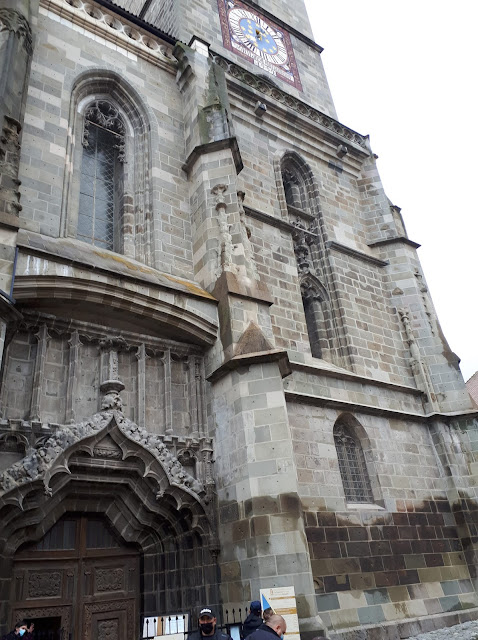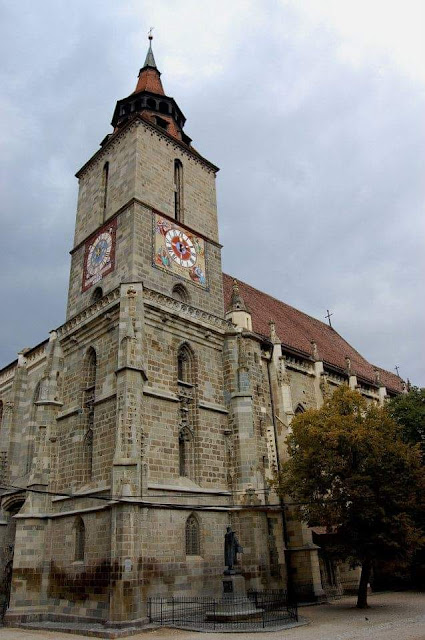
Brașov is located in the central part of the country, about 166 km (103 mi) north of Bucharest and 380 km (236 mi) from the Black Sea. It is surrounded by the Southern Carpathians and is part of the historical region of Transylvania.
The city is notable for being the regional capital of the Transylvanian Saxons of the Burzenland (Romanian: Țara Bârsei) administrative area in the past, and a large commercial hub on the trade roads between East and West. It is also the birthplace of the national anthem of Romania.
Brasov is the residence and also the largest municipality of Brasov County, in Romania, being also one of the largest cities in the country (declining in population in recent decades due to the exodus of Saxons and especially the reduction of industrial activity) .
In 2013, in Braşov, the first Olympics took place in Romania. The Olympic Flame was lit on February 2, during a special ceremony organized in Athens, and arrived in Bucharest the next day.

Points of atractions- Tourist objectives
The Council Square
The Concil Square was, in the Middle Ages, the place where fairs were organized in Brașov both for the Saxon and Hungarian merchants and for those who came from Romania. The market was reached through Vămii Street (now Mureșeni), and the goods were cleared near the street.
Since 1520, this place certified as a fair, named in documents Markplatz, has hosted many fairs.
The Council House in the center of the square was the place where every merchant had to place his goods, and city officials made sure that these places were respected.
Among the buildings on the square we can mention the Council House, the Church of the Assumption, the Merchants' House, the Filstich-Plecker House, the Mureșenilor House, the Museum of Urban Civilization Brașov. Near the square is the Black Church.
Piata Sfatului is probably the most well-known and visited place in Brașov, where various cultural and artistic events are organized, outdoor concerts such "The Golden Deer", etc.

Museums:
Black Church
The Black Church (Die Schwarze Kirche in German) is the parish church of the Evangelical Lutheran community in Brașov, located in the center of Brașov. The Gothic building was partially damaged in the fire of 1689, when its walls darkened and received its current name. The popular name after the fire, "Black Church", was officially accepted in the 19th century.
The Black Church is one of the most representative monuments of Gothic architecture in Romania, dating from the 14th-15th centuries. With a length of over 89 meters, it is considered to be the second largest church in Romania, after the Cathedral of the Salvation of the Nation and the largest Gothic building in Southeast Europe. Due to its size, when it was completed it received the title of The largest church between Vienna and Constantinople.
The organ of the Black Church, has 4000 tubes, 4 manuals with 56 keys each and a pedalboard with 27 keys, 76 registers and has 63 sound registers being considered among the largest in Europe, was built between 1836- 1839 by the organ builder Buchholz in Berlin and is famous for its sonority.
According to tourist estimates, about 100,000 tourists pass through the Black Church every year. The church is closed to visitors on evangelical holidays and during religious services for students, weddings, baptisms and other special events.
The first Romanian School near to St. Nicholas Church
The museum of the first Romanian school is housed in the building of the old Romanian school in the courtyard of St. Nicholas Church.
The first Romanian school, in Șchei, appeared before 1399, when a papal bull from December 25, 1399 confirms the existence of a place of worship and Orthodox teaching in Schei; with a series of teachers (Tempea family, Deacon Coresi, Dimitrie Eustatievici) and their own printing house.
First the church was built, of which the chronicles write in 1292. The first time this is mentioned in the documents from 1495, "the Holy Church and the Scout were built" by the care of the voivode Vlad the Monk, followed by Neagoe Basarab, Petru Cercel , Mihai Viteazul, Aron Vodă and on November 3, the same year 1495, Pope Bratu from Şchei writes in Sibiu, the first letter in Romanian.
In the classrooms of the old school there are "traces of the activity of Deacon Coresi, the greatest Romanian scholar and printer of the 16th century".

Braşov Fortress
One of the most important points of defense, located outside the fortress of Brasov, was the Fortress on the Road (called today the Fortress Hill).
At the beginning of the 15th century, there was only one watchtower in this place, which was completed in 1524 with a wooden bastion with four towers.
This construction was destroyed in 1529 by Petru Rareş's army, and in its place, a quarter of a century later, stone walls were built and ditches were dug.
The fire that took place in 1618 caused serious damage, so that in 1625, the fortress was almost completely rebuilt.
In 1627, an 81 m well was dug inside, and then in 1630, the fortress acquired the four bastions at the corners.
In the 17th century, it served as a warehouse, then a barracks for the locals. For this reason, for a while, the hill was called Dealul Plăieşilor.
From the 18th century until 1954, it served as a prison, then a depository for the State Archives of Brasov until 1975.
Starting with 1981, after an extensive restoration, it became a medieval tourist complex.

Braşov Art Museum
The Brasov Art Museum was founded in 1949 as a section of the Regional Museum. At first, in 1950, it operated on the first floor of the Casa Sfatului museum, being the first permanent exhibition of fine art.
The Art Department has moved since 1970 to the space where it currently operates.
The current building of the museum was built in 1902 for the Association of German Craftsmen in Brasov (Kronstadt Gewerbeverein).
The Brasov Art Museum was established as an independent institution on June 1, 1990, based on Decision no. 227 of June 11, 1990, by the detachment from the Brasov County Museum of the Art Section.
It functions as a public institution of culture, having its own legal personality, subordinated to the Braşov County Council, being a museum of county importance.
The rooms on the ground floor host temporary exhibitions and other cultural events (concerts, symposia, book launches).

Council House
Located in the old center of Brasov, in the square of the same name, the Council House (History Museum), is one of the most representative and visited buildings of Brasov.
Attested by the document from December 23, 1420, when the agreement concluded between the furriers' guild and the Assembly of the Bârsa Country District is mentioned. Following this agreement, the Assembly of the Bârsa Country District receives permission to build, above the vault for the sale of the guild, a room for "granting justice" and for the meetings of the city council.
Thus, in the central square of the old fortress, the city hall was built in 1420, formerly called "Rathaus" or "Council House".
At the beginning of the 16th century, the documents of the time mention the construction of the tower, guarded by four small towers (sign of the death penalty), from where the guards watched the city day and night, announcing by trumpet sounds (hence the name " The Tower of the Trumpeters ”) the passage of time, the outbreak of fires or the coming of enemies. From the moment the city-fortress becomes stronger from an economic, commercial and military point of view, the Council House receives new rooms, and the tower will be provided with a clock with dials on each of the four sides.

Museum of Ethnography
The Museum of Ethnography from Brașov operates in an annex building of the Art Museum, the access to it being made through the extreme right of the building.
This museum is dedicated to the regional ethnology of southeastern Transylvania, illustrating its valuable heritage of over 1000 pieces, the civilization of rural communities in the Bran area, Rupea area, Făgăraș County, Olt County and Bârsa Country.
For this reason, as an administrative structure, the Museum of Ethnography operates in three localities: Brașov, Săcele and Rupea.
In the central pavilion of Brașov is organized a large and permanent exhibition that includes, in a short treatment, a profession common to all ethnographic areas: the craft of weaving and its functional application both in the organization of the interior and in folk costume.
The presentation is an authentic one, with a documentary-pedagogical character, with emphasis on the reconstruction of the authenticity of the rural context through specific tools, technologies and products.
Another section of the Museum of Ethnography is the Museum of Urban Civilization, which operates in Council Square, at number 15, opposite the Corona shopping galleries.

Historic buildings and areas
House Johannes Honterus Braşov
In this location, where is currently the high school that bears his name (in the Court of Honterus no. 3), opposite the Black Church, lived the Transylvanian humanist Johannes Honterus (who lived between 1498 - 1549), being a well-known author of treatises history, geographical atlases and textbooks.
In 1533, the humanist Johannes Honterus founded the first printing house in Brasov, followed by the first gymnasium in the town, in 1544.
He established the school and the Studium Coronense library, where students from all over Transylvania, Hungary, Germany and the Netherlands will come. This school is named after him today.
"The Brasov of these times stands out - compared to other cities - by cultivating science," said the great Saxon humanist and reformer in 1548 in a letter to Sebastian Munster, a professor at the University of Basel. The prestige of the school and library established by Honterus in 1541 are of international notoriety.
Johannes Honterus introduced religious reform to the Saxons in Ţara Bârsei, and in 1547 the Principality's Diet also accepted the Lutheran religion as one of the four official religions admitted to Transylvania.









Comments
Post a Comment